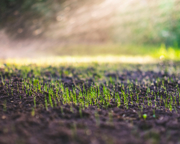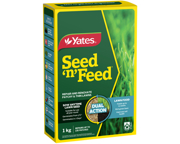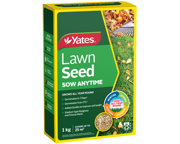Yates Account
Join now
Create a Yates account today!
Sign up to join the Yates Garden Club for monthly e-mails packed with seasonal inspiration, tips for success & exclusive promotions.
Plus if you’re a Garden Club member you can take part in the Yates Growing Community - a blog to share successes, get advice & win prizes in fun challenges along the way!

Forgot password
Enter the email address associated with your account, and we'll email you a new password.

We’ve put together our key mowing tips in one place, for quick reference.
Even if you've been mowing since last Century, we bet you'll find something useful here. Including those things you already know you should be doing, but aren't. And if you are new to mowing, enjoy!
Mowing Masterclass
- New lawns should be allowed to develop good leaf growth before the first cut (at least five centimetres tall). Hold off mowing a new lawn for as long as you can bear it! Set the mower to its highest setting for the first mow and decrease it gradually over successive mows.
- Don’t remove more than 1/3 of the leaf blade in a single mowing session.
- Regular mowing is best. While it’s tempting to sneak a weekend off mowing, regular mowing is up there as one of the best things you can do for lawn health.
The 1/3 rule is our main guide for knowing when to mow, because if you’re cutting off more than 1/3, you’re damaging the lawn. So, either raise the mower height or mow more regularly.
Pro tip: Use of controlled release fertilisers such as Yates Lawn Fertiliser Twice a Year can prevent surge growth, so you can get greening without heaps of extra growth and more mowing. - Never mow too low. Mowing the lawn hard (or scalping) has the opposite effect to what's intended. It's tempting to think that if you mow hard, the lawn won't need mowing for an extended period. But if you do mow aggressively, it makes the lawn bolt, forcing a surge of growth that burns extra nutrients. Repeated hard mowing weakens your lawn, allowing weeds and moss to get a foothold; which in turn means more frequent mowing. Weeds grow faster than grass and go to seed faster, which means weeds proliferate.
This results in...you guessed it: yet more mowing. Ultimately, harsh mowing means more expense and extra maintenance in the long term. - Cool season grasses like it longer. For established lawns, cut cool season grasses (e.g. ryegrass, fine fescue, tall fescue or browntop/bent) to between 3 and 10 cm, and cut warm season grasses (e.g. kikuyu or couch) shorter, to 2.5 cm high. Cut as frequently as possible and remove as little growth as possible during each mow. Keep grass a little longer in the hottest part of summer so the roots stay cool. Winter is a balancing act; keeping the grass longer allows for more photosynthesis while sunlight hours are reduced, but during periods of heavy rain shorter is better, to discourage lawn diseases.
If you’re not sure what type of grass you have, it’s a likely bet that your lawn will be a cool season blend in NZ. Usually, warm season grasses are found in coastal areas, in the warmer parts of the country.

- Recycle lawn clippings, or use a mulching mower. It’s good practice to use a catcher for lawn clippings, to avoid leaving thick clumps of clippings on the lawn. But it’s also good to remember that when removing the leaf blade, you’re removing plant nutrients stored in the leaf. A smart way to minimise the need for fertilising is to reduce the clippings you remove. If you aren’t taking much off when you mow and the lawn is nice and dry, consider leaving the catcher off. Make sure the clippings are dispersing nicely. This isn’t a long-term practice, but now and again (once a month or so) it can be beneficial to your lawn.
Alternatively, you can use a mulching mower and get the benefit all the time; plus, you never need to empty the catcher!
Pro tip: If you’ve recently applied a selective herbicide to your lawn don't add the clippings to your compost or use them as mulch. Wait 4-6 weeks before resuming composting your clippings. Check the herbicide label for advice. - Keep an eye out for 'thatch'. Thatch is the build-up of old grass and other dead material that collects at the base of the grass plants. Scarifying or scraping it away will allow air movement around the grass stems and reduces the incidence of fungal diseases.
It’s not all bad; a moderate level of “active” thatch in a home lawn can actually protect the soil from sudden changes in temperature, protecting roots from extreme cold or heat. It can also help reduce moisture loss from transpiration.
However, if the thatch gets thick enough that it’s not being broken down efficiently by microbes, it can build up enough to prevent moisture penetration and increase the risk of disease and insect damage.
Pro tip: Yates Lawn Fertiliser Quarterly Hose-on can help boost these thatch-loving microbes, as it contains humates to stimulate the microbial community in your lawn soil. - Mow sparingly when it’s very hot. During hot weather it's best to let the lawn grow a little longer than usual, to reduce stress.
- Never mow a wet lawn. Even with a sharp mower blade it tears and damages the grass. Wet grass clumps together when it’s cut and sticks to the underside of the mower; if it stays there it can encourage corrosion of the mower body.
- Check your mower blades. Blunt mower blades make a poor job of cutting and will rip and tear the grass. If you look at the ends of mown grass leaves, you’ll notice little strings of fibre on the cut end where it's frayed and damaged. That’s a signal you’re overdue for sharpening your blades. Sharp mower blades make a cleaner cut and cause less stress to the grass, which helps it recover faster.
Pro tip: The quality of the cut is controlled by a combination of number of blades, speed of progress, blade tip speed and blade sharpness. Make certain your blades are sharp, slow your walking speed right down and crank up the mower to full throttle, for best results. - Wear safe footwear. Nobody wants to hear “I told you so” after mowing in jandals!
Our step by step guide to create a beautiful lush lawn, with seed. It's a little more work starting from scratch, but it pays off with an absolutely gorgeous result.
How to maintain your lawn (and freshen it up with seed)
Our guide to looking after your lawn, to keep it in peak condition. All the regular maintenance tips and tasks, including how to over-sow with seed to thicken up a lawn.
Why and How to Fertilise your Lawn
Lawns are made up of many thousands of small, hungry plants, that all consume energy. Seasonal bursts of growth and regular mowing can deplete the lawn’s energy reserves, so here's how to top it up.
Lawn Watering Tips
Ever wondered how often you should be watering your lawn? Check out our lawn watering tips!
Related products
Yates Insect Killer for Lawns
A fast-acting, highly effective insecticide for use on lawns. The granular formulation kills insect pests on contact.
Yates Seed'n'Feed
An easy to use lawn repair product, containing all the ingredients you need to fix bare patches and thicken an existing lawn. Dual-action formula germinates rapidly all year round, while feeding for up to 12 weeks.
Yates Weed 'n' Feed Double Action - Hose On
Effectively kills weeds, feeds & greens lawns in one easy step. Controls common broadleaf weeds, with added nitrogen & iron for a healthy green lawn.
Yates Lawn Fertiliser Twice A Year
Simply feed your lawn twice a year. A pro grade controlled release fertiliser that releases nutrients for up to 6 months, to feed your lawn in a precise controlled fashion - that keeps pace with your lawns nutrient demands.
Yates Lawn Grub & Porina Kill + Protect
Powered by Acelepryn® technology to eliminate a wide range of soil-dwelling lawn pests and provide up to 6 months protection.
Sow Anytime Lawn Seed
A blend of high grade seed that has the ability to grow all year round: Yates Sow Anytime will germinate at temperatures as low as 3°C. Produces a vibrant green, lush lawn.



















Share
Share this article on social media